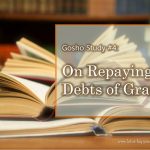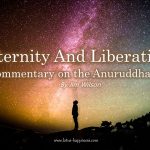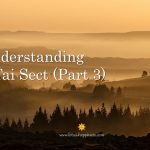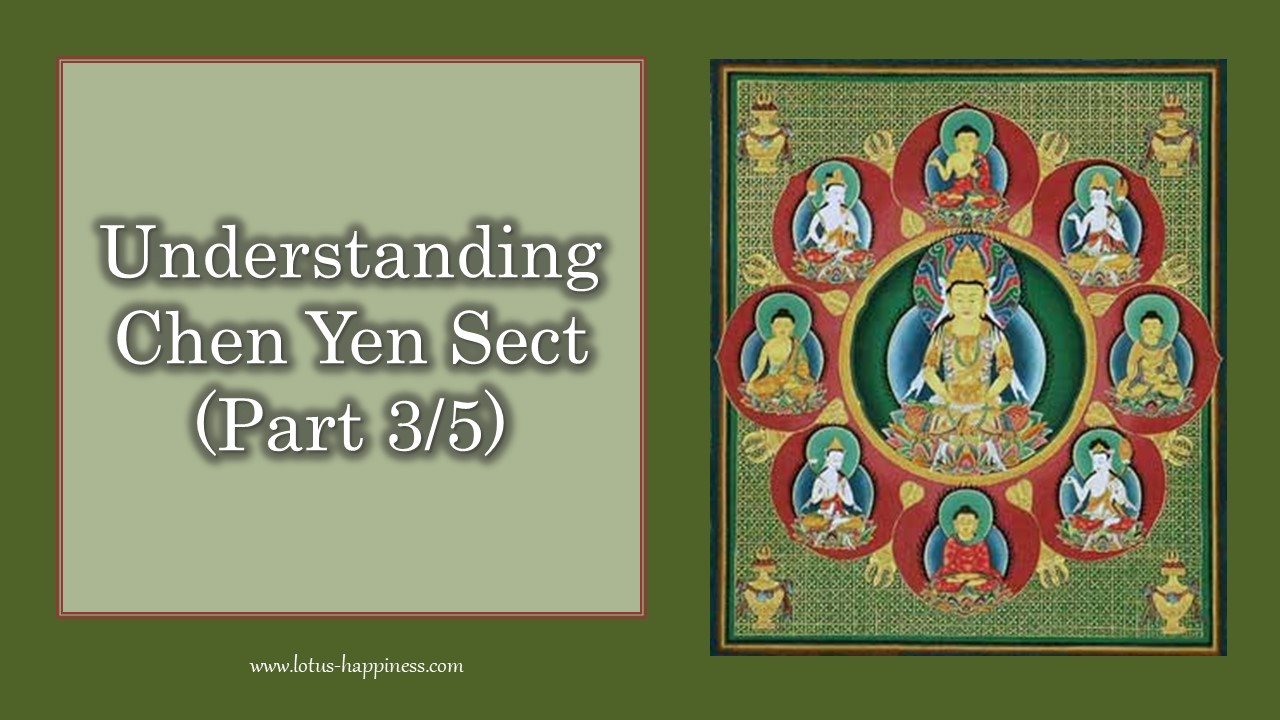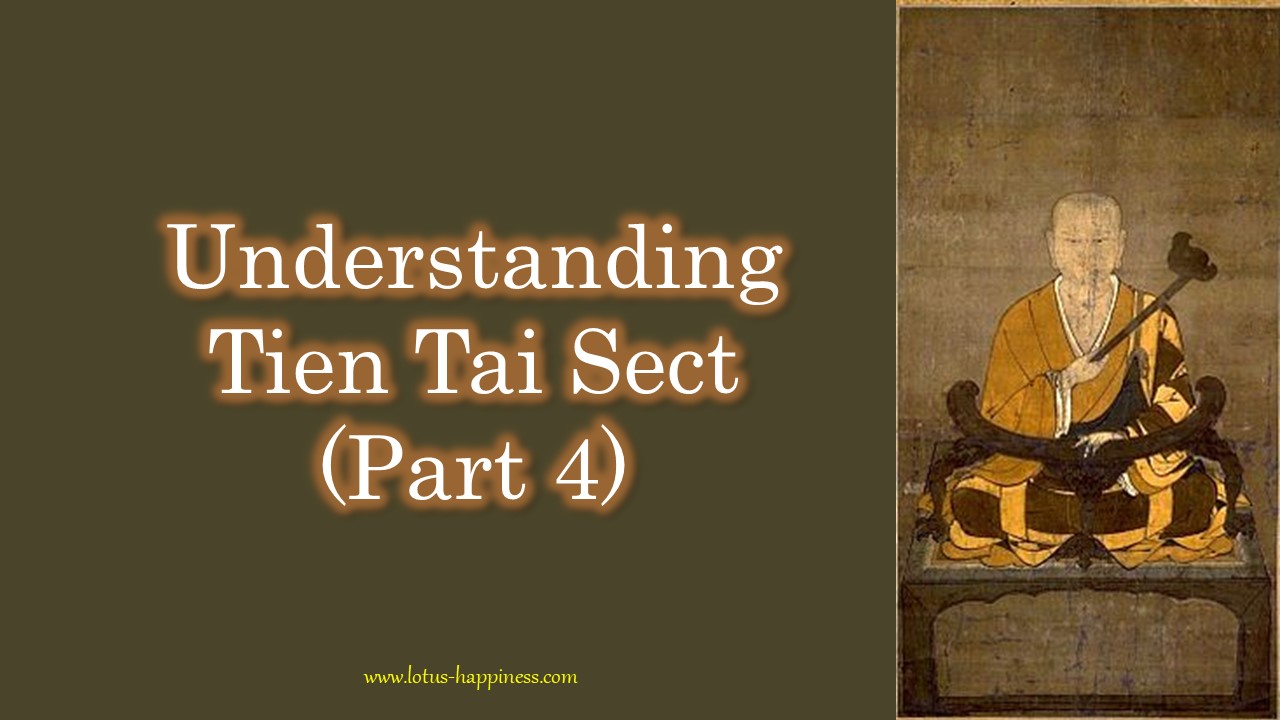The Essence of Chapter 2: Expedient Methods
Why It is Not the Ten Factors Emphasized by Nichiren Buddhism
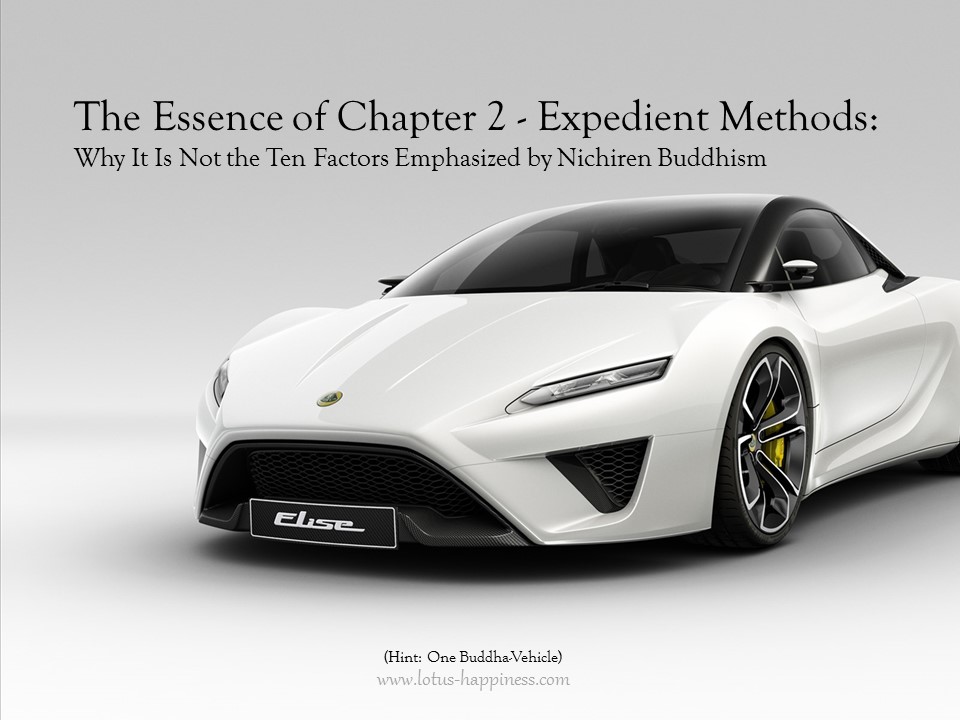
While all chapters of the Lotus Sutra are equally enlightening, Chapter 2 is particularly illuminating. This is because the key teaching begins in Chapter 2 and the Buddha is essentially “revealing the truth by opening the gateway of the Expedient Methods”.
Looking up in the dictionary, the word “expedient” means “skillful”, “convenience”, or “pragmatism”. By having the expedient or skillful means, the Buddha is applying immeasurable ways to guide all people to the path of Buddhahood. Simply put, embracing the Lotus Sutra is not the only way toward Buddhahood. In the final stanzas of Chapter 2 (Lotus Sutra 2: 5.1 – 5.100), the Buddha expounds some of the diverse ways through which people attain Buddhahood:
- people who are kind-hearted and benevolent,
- people who practice Six Paramitas,
- people who paint, sculpt, or carve Buddha’s images,
- people who construct Buddhist temples
- people who sing songs in praise of the Buddha’s virtues
- people who give offerings to worship Buddha’s images (and the list goes on).
“However, if the person hears about the Lotus Sutra, ponders and practices it, then you should know that this person is very near Supreme Perfect Enlightenment. Why? Because all bodhisattvas attain Supreme Perfect Enlightenment through the Lotus Sutra. The Lotus Sutra is the gateway through which the reasons of expedient methods are openly explained, thus revealing the Ultimate Truth. The treasury of the Lotus Sutra is deeply hidden so that it is not within easy reach. Yet now, the Buddha teaches, transforms, and leads the bodhisattvas to attaining enlightenment by opening and revealing the truth for them. (Lotus Sutra 10: 2.8)
Hence, practicing Buddhism – be it Theravada, Mahayana, or Vajrayana – will result in Buddhahood, albeit some of these may take quite a while to reach Supreme Perfect Enlightenment.
Now, what is the essence of Chapter 2?
Ten Factors Is Not the Essence
For Nichiren schools of Buddhism (Nichiren Shu, Nichiren Shoshu, Soka Gakkai etc), daily Buddhist practice comprising chanting the daimoku ( title of the Lotus Sutra) and reciting gongyo (reciting sections of Chapter 2 and Chapter 16 of the Lotus Sutra).
The selected portion in Chapter 2 starts from the beginning of Chapter 2 and ends at the Ten Factors (Lotus Sutra 2: 1.1 – 1.5). Given the perceived importance, the Ten Factors is repeated thrice during recitation.
“O Shariputra! I will stop here and say no more. This is because the Law attained by the Buddha is the foremost, exceptionally rare, and difficult to comprehend. Only among Buddhas can the true aspects and characteristics of the ultimate Law be fully grasped. The ultimate Law consists of such an appearance, such a nature, such an entity, such a force, such an action, such a cause, such an environment, such a result, such an effect, and such a coherent consistency from the beginning to the end.” (Lotus Sutra 2: 1.5)
In fact, both in Tian Tai and Nichiren Buddhism, the Buddhist concepts of Ten Worlds and Ten Factors are held with so much reverence and importance that the design of the Gohonzon (object of worship) as well as the principle of “Three Thousand Realms in a Single Moment of Life” are all derived from the Ten Worlds and Ten Factors.
Nevertheless, if one scrutinizes the core teaching of Chapter 2, the essence of which lies not in the Ten Factors. Here’s why.
An Overview Analysis of the Flow of Events in Chapter 2
First, we need to take a holistic understanding of the flow of events in Chapter 2.
Generally, Chapter 2 can be split into 5 sections:
Section 1: Paragraphs 1─22
First, the Buddha began his discourse without any of his disciples raising a question. (This is contrary to the norm because usually a disciple will raise a question for the Buddha to begin a teaching. This also indicates that Chapter 2 carries important message of the Buddha’s teaching.)
Next, the Buddha started to praise the wisdom and expedient methods of Tathagata, much to be bewilderment of his disciples. Then, the Buddha described the characteristics of his Buddha-Law in the form of the Ten Factors, followed by a recitation of stanzas to summarize his teachings.
Section 2: Paragraphs 1─10
Many of his disciples were confused about the direct way in which the Buddha explained the Buddha-Law.
Shariputra entreated the Buddha to teach for the first time.
Section 3: Paragraphs 1─8
Shariputra entreated the Buddha to teach for the second and third time.
Section 4: Paragraphs 1─15
Here comes the crux of the event:
Before the Buddha began his discourse, 5000 disciples – both monastic and lay persons alike – left the congregation altogether. (This is considered an earth-shattering event. Why would anyone choose to give up listening to the Buddha’s teachings?)
Those who left the congregation were arrogant people with deep negative karma. They thought they had “attained what they had not attained and imagined they had realized what they had not realized.”
(Note: 5000 is not 5 or 500, it is relatively a huge number.)
It was only after the departure of the 5000 disciples that the Buddha began his discourse on the “One Buddha-Vehicle”, which is the revelation of the Law of Supreme Perfect Enlightenment. Hence, Ten Factors, which is expounded before the departure of his disciples, is not the essence of Chapter 2.
Section 5: Paragraphs 1─100
The Buddha recapped his teaching by reciting the stanzas.
The Essence of Chapter 2 is the One Buddha-Vehicle
Before the departure, the Buddha only praised and described “the Law of Cause and Effect” characteristics of the Buddha-Law.After the departure, the Buddha explicitly explained his purpose to be born on Earth: to teach the One Buddha-Vehicle for the universal enlightenment of all living beings.
He went on to reiterate that there are no two or three vehicles to attaining Buddhahood, only One Buddha-Vehicle. It was only out of convenience or expediency that the Buddha differentiated his teachings in three different ways via the Expedient Methods. It was only out of convenience or expediency that the Buddha differentiated his teachings in three different ways by teaching:
- Four Noble Truths (for Shravakas, or Voice-Hearer, or those who hear the Buddha’s teachings for the first time),
- Twelve-Linked Chains of Causation (for Pratyekabuddha, Cause-Awakened Ones), and
- Six Paramitas (for Bodhisattvas).
The essence of Chapter 2 begins in Section 4, from Paragraph 4.1 to 4.15. The key word “One Buddha-Vehicle” has been repeated a total of seven (7) times. Here are some of the quotes:
The Buddha continued to speak to Shariputra: “O Shariputra! This is the one great reason for all Buddhas to appear in the world. Buddhas-Tathagatas only teach and transform bodhisattvas. All their actions are done for one purpose—that is to show and awaken all living beings to the Buddha’s insights. O Shariputra! Tathagata has only the One Buddha-Vehicle by which to teach all living beings; there is no other, neither the second nor the third Vehicle. O Shariputra! The teachings of Buddhas in the ten directions are identical. (Lotus Sutra 2: 4.7)
“O Shariputra! All present Buddhas-Bhagavats, dwelling in the ten directions in immeasurable hundreds of thousands of millions of billions of Buddha-lands, bring an abundance of benefits, blessings, peace, and joy to living beings. This is also due to the Buddhas applying immeasurable expedient methods—causes and conditions, metaphors, similes, analogies, parables, and various linguistic expressions using words, poetry, prose, and so forth—to teach, explain, and illustrate the various doctrines to living beings. Because all these doctrines are derived from the One Buddha-Vehicle, living beings, having listened to the doctrines of the Buddha, will eventually attain the perfect wisdom. (Lotus Sutra 2: 4.10)
“O Shariputra! The Buddhas only teach and transform bodhisattvas. They do so because they desire to show all living beings the Buddha-Wisdom, to awaken all living beings to the Buddha-Wisdom, and to lead all living beings in entering the Buddha-Wisdom. O Shariputra! I am the same as the rest of the other Buddhas. Knowing the various desires and attachments deep in the hearts of living beings, I adapt my teachings according to their natures and capacities using the power of expedient methods—causes and conditions, metaphors, similes, analogies, parables, and various linguistic expressions using words, poetry, prose, and so forth—to teach, explain, and illustrate the Law for them. O Shariputra! All these teachings are derived from the One Buddha-Vehicle—the source of the perfect wisdom. O Shariputra! In the ten directions of the Universe, there is no second Vehicle, let alone a third. (Lotus Sutra 2: 4.11)
“O Shariputra! The Buddhas appear in the evil worlds of five defilements, namely the defilement of kalpa, the defilement of suffering, the defilement of living beings, the defilement of views, and the defilement of lifespan. O Shariputra! In the age of chaotic kalpa, the impurities run deep. Living beings—being stingy, greedy, and envious—will not be planting virtuous roots. Therefore, all Buddhas, by applying the power of expedient methods, make differentiations to the One Buddha-Vehicle by teaching it as though there are three different Vehicles. (Lotus Sutra 2: 4.12)
Apart from teaching the One Buddha-Vehicle, the Buddha also admonished that if any of his disciples should claim that they have attained arhatship without having the aspiration of Buddhahood, then they are people of excessive arrogance and they are not disciples of the Buddha.
“O Shariputra! If any of my disciples should claim to be arhats or pratyekabuddhas and yet are ignorant to the fact that all Buddhas only teach and transform bodhisattvas, then he is no disciple of mine. He is neither an arhat nor a pratyekabuddha. (Lotus Sutra 2: 4.13)
“O Shariputra! Moreover, if any of the monks or nuns should claim that they are already arhats dwelling in their final rebirth and imagine themselves attaining final nirvana without having the aspiration to seek Supreme Perfect Enlightenment, then you should know that they are people of excessive arrogance. Why? Because it is impossible for a true arhat not to believe in this Law; unless there is no existing Buddha after the parinirvana of the Buddha. Why do I say so? Because if the Buddha has entered parinirvana, it will be even more difficult to find people who can accept, embrace, read, recite, and understand the meanings of the Law. But if they happen to meet other Buddhas, then they will refresh the determination to attain Supreme Perfect Enlightenment. (Lotus Sutra 2: 4.14)
“O Shariputra! You should have a focused mind to believe, understand, accept, and embrace the words of the Buddha because the words of the Buddha are the Ultimate Truth. There are no other Vehicles, only the One Buddha-Vehicle.” (Lotus Sutra 2: 4.15)
What’s In It For You?
Now that we have learned the essence of Chapter 2, what’s in it for you?
By having an awareness of the essence of Chapter 2, you will then be able to gain a greater appreciation, gratitude, joy in the Buddha’s teaching of the Law of Supreme Perfect Enlightenment (One Buddha-Vehicle).
If you wish to make your daily practice on Chapter 2 more effective, productive, and meaningful, you may choose to focus on Section 4, Paragraph 4.1 – 4.15 for your recitation or meditation.
Picture Summary
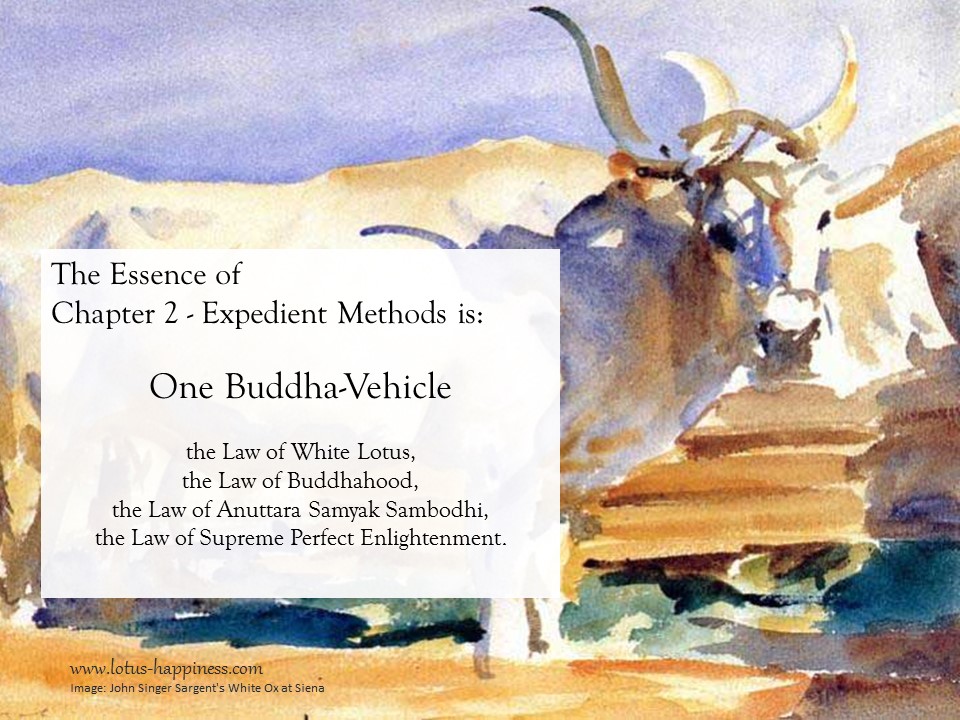
Next Sunday
The topic for Next Sunday is the Four Noble Truths. Here is the upcoming blog posts in June.
Let’s Connect Now
Follow us by Liking our Facebook
Subscribe our Newsletter
Support Lotus Happiness
Do support Lotus Happiness in the Dharma propagation by purchasing a copy of the Lotus Sutra in the Amazon.
PDF Ebook is available for purchase – The Lotus Sutra and Its Opening and Closing Sutras.
Share with your Friends
Enjoying the post? Leave a comment or share with your friends!

